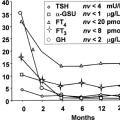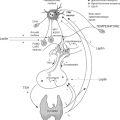Thyrotoxicosis of Extrathyroid Origin
Angela M. Leung
Joshua D. Safer
Extrathyroidal causes of thyrotoxicosis can be difficult to diagnose. The most common cause is exogenous thyroid hormone ingestion or exposure. The other causes, functional metastatic thyroid carcinoma and struma ovarii, are extremely rare.
Exogenous Thyroid Hormone
Causes
Thyrotoxicosis due to the ingestion of exogenous thyroid hormone is most frequently iatrogenic from thyroid hormone replacement therapy, as when sodium levothyroxine (LT4) is overly vigorously prescribed for hypothyroidism (1). Other causes of thyroid hormone therapy may be intentional, as when LT4 is given to suppress thyroid stimulating hormone (TSH) levels and inhibit tumor growth in thyroid cancer patients or to decrease goiter size in euthyroid patients.
Thyrotoxicosis may also result from patients’ surreptitious use of thyroid hormones [LT4, liothyronine (LT3), a mixture of these two, or thyroid extract], which usually occurs in the setting of psychiatric illness. Surreptitious thyroid hormone ingestion is more common in those working in healthcare-related fields who have more readily available access to thyroid hormone-containing medications (2) and may occur at any age (3).
Large doses of thyroid hormone may be ingested as a suicide attempt. In addition, some patients may ingest supraphysiologic doses of thyroid hormones, sometimes at the advice of their physicians, in an effort to lose weight (4,5,6,7,8). One report described thyrotoxicosis occurring in a woman after the injection of thyroid hormones subcutaneously to reduce local fat and cellulite (9). Inadvertent exposure to thyroid hormone resulting in thyrotoxicosis has been reported from occupational exposure to cosmetic creams containing iodine and thyroid hormones (10) and from accidental dosing with veterinary LT4 preparations (11). Thyroid hormone replacement has also been used to treat depression (12), menstrual disorders, and infertility (13) in euthyroid individuals.
Patients may also develop thyrotoxicosis from the unintentional ingestion of thyroid hormone. Accidental overdose of thyroid hormone most frequently occurs in children (14,15). Several community outbreaks of thyrotoxicosis from exogenous thyroid hormone ingestion have been reported. During the mid-1980s, thyrotoxicosis associated with a low radioactive iodine uptake was observed in an outbreak of 121 individuals in southwestern Minnesota and adjacent areas (16). Subsequent investigations revealed that this was due to the ingestion of ground beef containing parts of bovine thyroid glands obtained during the harvesting of laryngeal trimmings at a single local slaughtering plant. This type of community-wide thyrotoxicosis has been referred to as “hamburger thyrotoxicosis”
(16). Beef-slaughtering techniques were also likely responsible for a similar community outbreak in Nebraska in 1984 (17), recurrent thyrotoxicosis due to episodic ingestions of contaminated beef in one Canadian individual (18), and thyrotoxicosis from sausage consumption in an elderly Dutch man (19).
(16). Beef-slaughtering techniques were also likely responsible for a similar community outbreak in Nebraska in 1984 (17), recurrent thyrotoxicosis due to episodic ingestions of contaminated beef in one Canadian individual (18), and thyrotoxicosis from sausage consumption in an elderly Dutch man (19).
Clinical Presentation and Diagnosis
Diagnosis of thyrotoxicosis resulting from exogenous thyroid hormone ingestion can be difficult and requires a high index of clinical suspicion, as symptoms, initial laboratory values, and imaging studies are often indistinguishable from those of painless sporadic thyroiditis or other types of thyrotoxicosis associated with a low radioactive iodine uptake. Serum TSH values are suppressed, and serum T3 and T4 levels are variably elevated, depending on the thyroid hormone preparation that has been ingested. LT3 poisoning may result in more severe and acute symptoms of thyrotoxicosis than ingestion of other forms of thyroid hormone (20). Recent case reports describe the unusual presentation of thyrotoxic periodic paralysis arising from LT3 ingestion taken for weight loss (4) and severe hypercalcemia secondary to the ingestion of thyroid hormones (21).
Because of the TSH suppression, the thyroid gland is small in patients without underlying thyroid disease. Exophthalmos is not present. Radioactive iodine uptake is low or undetectable. Measurement of serum thyroglobulin (Tg) is frequently helpful, as the level is low or undetectable in thyrotoxicosis due to exogenous thyroid hormone, but elevated in all other causes of thyrotoxicosis, including Graves’ disease, toxic nodular goiter, painless sporadic thyroiditis, and subacute thyroiditis (22,23). However, if serum Tg-antibodies are present, serum Tg measurements are not reliable (24), and fecal T4 levels may be measured instead in such patients. Fecal T4 levels are approximately 1 nmol/g in normal healthy subjects, are mildly increased in Graves’ disease (about 2 nmol/g), and are markedly elevated in individuals with thyrotoxicosis due to exogenous thyroid hormone (over 12 nmol/g) (25). Finally, color-flow Doppler sonography has been used to distinguish Graves’ disease or toxic nodular goiter, in which the thyroid is hypervascular, from thyrotoxicosis secondary to exogenous thyroid hormone ingestion, in which thyroid hypervascularity is absent (26).
Treatment
In most cases, the only therapy required is the discontinuation of exogenous thyroid hormone ingestion. Although high doses of thyroid hormone have been reported to cause seizures (27), myocardial infarction (1), thyroid storm (28), and in a rare case, choreathetosis (a movement disorder of acute onset) (29), even massive overdoses of thyroid hormone are usually well tolerated, especially by children (14,27). Beta blockers may be helpful in patients with severe symptoms of thyrotoxicosis (2). Antithyroid medications have no role in therapy since thyrotoxicosis is not the result of endogenous thyroid hormone production.
In patients seen acutely after massive thyroid hormone overdose, gastric lavage, induced emesis, and activated charcoal may be employed to prevent thyroid hormone absorption (30). Although conservative therapy is adequate in most cases (30), adjunctive therapies may be required in patients who do not respond to conservative measures or who are considered to be at high risk for cardiac or neurologic complications. Cholestyramine will facilitate a more rapid decrease in circulating thyroid hormone levels by binding thyroid hormone from the enterohepatic circulation and increasing fecal excretion (31). The iodinated radiocontrast agent, iopanoic acid, will decrease thyroid hormone toxicity by decreasing the conversion of T4 to T3 (15,32). One report described two unusual cases of refractory hyperthyroidism, due to suspected thyrotoxicosis secondary to exogenous thyroid hormone, that were successfully treated with octreotide (33). As a last resort, plasmapheresis and exchange transfusion may be employed (34).
Thyrotoxicosis Due to Metastatic Thyroid Carcinoma
Definition and Epidemiology
Thyrotoxicosis due to metastatic well-differentiated thyroid carcinoma is extremely rare (35), but has been described in over 70 case reports since its first description by Leiter et al. in 1946 (36,37). Its incidence peaks in the fifth decade, it is 2 to 3 times more common in women (38), and frequent sites of the metastatic disease are bone, lung, and mediastinum (37). Thyrotoxicosis secondary to metastatic anaplastic thyroid cancer has been described in just a few case reports (39,40).
Although thyroid carcinomas are almost invariably hypofunctional, even tumors that are relatively inefficient at thyroid hormone production may cause thyrotoxicosis in the presence of an extremely large tumor mass, especially in patients with diffuse metastases. In several reported cases of thyrotoxicosis due to hyperfunctional metastatic thyroid carcinoma, all of whom had concomitant Graves’ disease, thyroid-stimulating immunoglobulins in patients’ sera likely caused thyrotoxicosis by stimulating the tumors’ TSH receptors (41,42,43). An activating single-nucleotide tumor mutation of the TSH receptor gene was detected in a case of hyperfunctional metastatic insular thyroid carcinoma (44).
Stay updated, free articles. Join our Telegram channel

Full access? Get Clinical Tree








